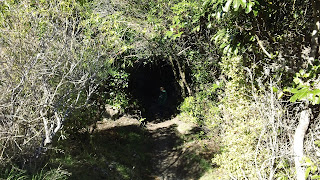That was enough for us - we decided a boil up would be our dinner that night. Turns out, a boil up is a traditional Maori meal. You boil a bunch of meat and vegetables into a kind of hybrid soup-stew. Then you eat it. One thing that is a bit hard to describe (and I'll do a post on it later) is the role of the Maori in New Zealand. We live in a place with many people who live in a way that honors the traditional Maori way of life. A huge percentage of folks around here have some Maori in their family. Most of the people approaching us at the market looked like they were likely Maori or part-Maori, though not everyone who looks Maori is Maori and not everyone who looks pakeha (non-Maori) is not Maori. Facial tattoos are an obvious marker, but many people have tattoos and only a small number around here have the traditional tattoos that are obviously Maori. Puha is a traditional Maori food - it is a member of the thistle family, it is often found growing as a weed in the yards around here, and it is fairly bitter. I guess you could compare it to dandelion greens. ("Puha! Puha! Got you all in check!") (No one in my family thought that was funny. Help me out, Hillside Place.)
Pork bones are not exactly traditional, but it seems the major reason to buy them in New Zealand is for a boil up. I found them at our local butcher. When I asked which bones (there was a choice) I should use for a boil up, the other customer turned to me and gave me advice, as she was also making a boil up that night. She happened to also be in the produce market next door just after I left the butcher, so she also pointed me to the right kumara. Kumara are small sweet potatoes - the best ones are purple, of course. I also bought potatoes, small dark brown ones that she suggested. Between the pork bones, the potatoes, and the kumara, I was definitely setting a personal record for most food weight per dollar. All in all, I spent 20 dollars and had some seriously dense eats.
When we got home, I got to work. Here are the bacon bones:
Here is the bag of puha:
Here is a kumara:
Here is a suspect bacon bone. It is strange to be in a situation where best case guess is pig tail:
Here are pots full of soon-to-be-boiling bacon bones. I don't have a big pot, so I used two:
Boiling produced an attractive scum on top. In retrospect, I should have removed this scum.
Here are the peeled and cut up kumara. They were hard as rocks.
And then I peeled and added the potatoes:
Then I threw them all in the boil up:
A traditional Maori sourdough potato bread is called rewena. We also bought this huge hunk of a loaf at the market. It was also extremely dense.
While the potatoes and kumara boiled, I prepared the puha.
The stalks exude a natural white latex. You can see it below. I tasted it. Man, it was super acrid. That was something I regretted doing.
I removed all the stalks and then rubbed the leaves under running water. I read if you did that, some of the bitterness of the leaves was removed. Seemed to work, because the puha was delicious. Here it is all together:
It was a lot of work to remove the leaves and wash them, so I didn't use all of the puha. In fact, here is what was left - most of it:
After five minutes of boiling more, we took it out. Here is what it looked like:
And here is the full meal with a piece of rewena next to the boil up.
In the end, we liked some of the boil up, but not all. The puha was great and Evelyn put a bunch more into the leftovers after dinner. I thought the kumara was amazing and I wished we had more of it. The potatoes were good, but not too exciting. I also boiled them too long, so they were a little soft. The pork lent a delicious taste to the broth and to the vegetables, but the meat itself was not really to my liking. Maybe I just don't like boiled pork parts. I liked the rewena, though eating potato bread with potato soup was a lot of potato in one meal. The meal was certainly filling and it was definitely thrifty.
In the end, we removed the remaining pork parts, added more puha, and put the leftovers away for another meal. And no, we did not eat the tail. I couldn't bring myself to do anything other than remove it from the pot and dispose of it. Maybe next time.



































































